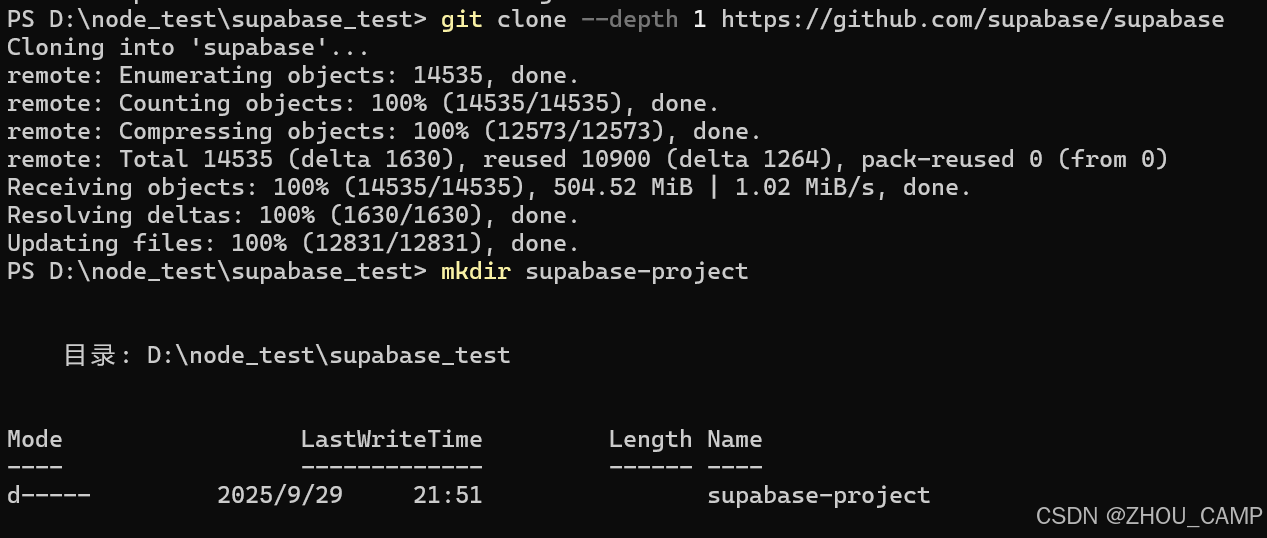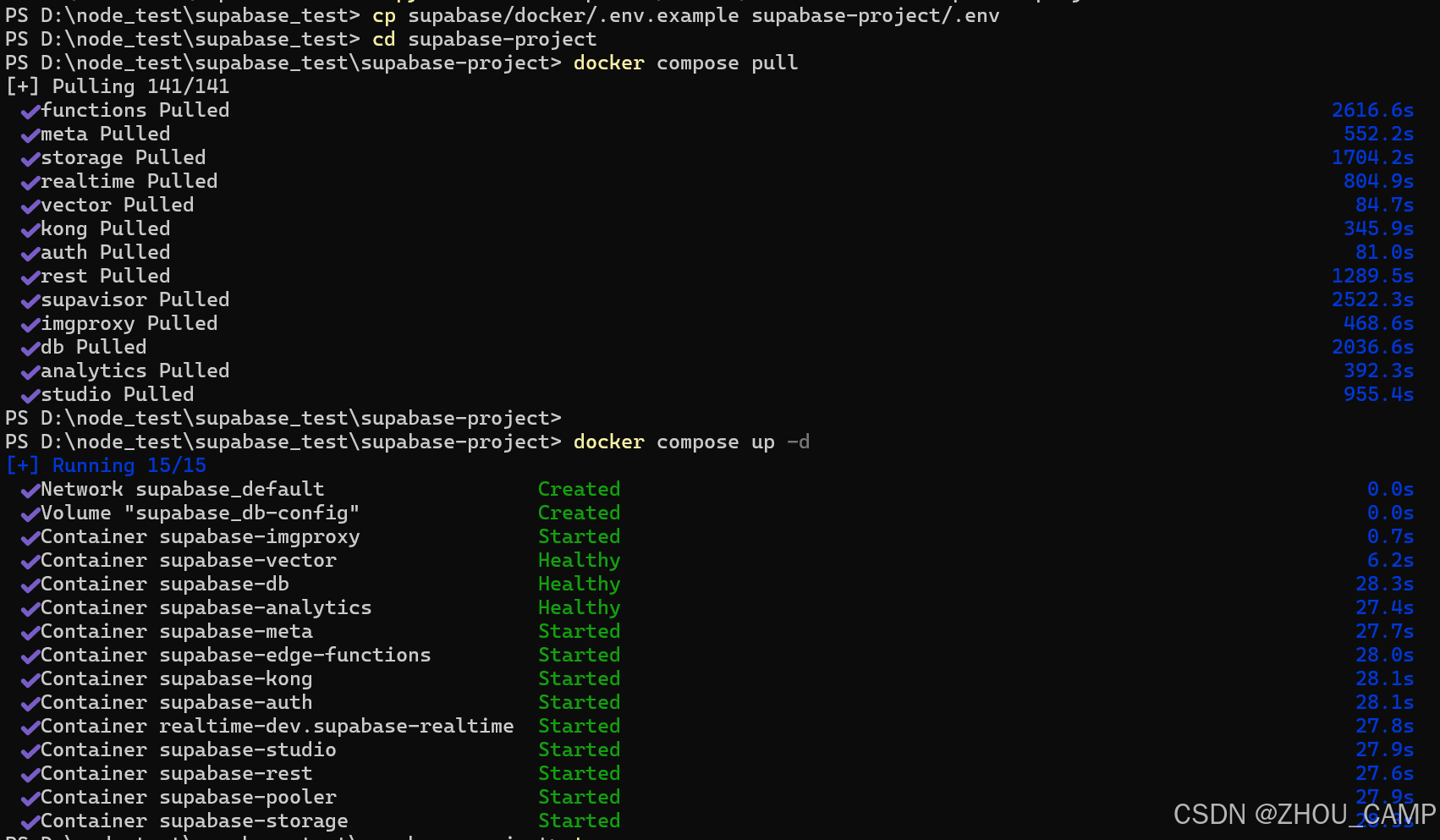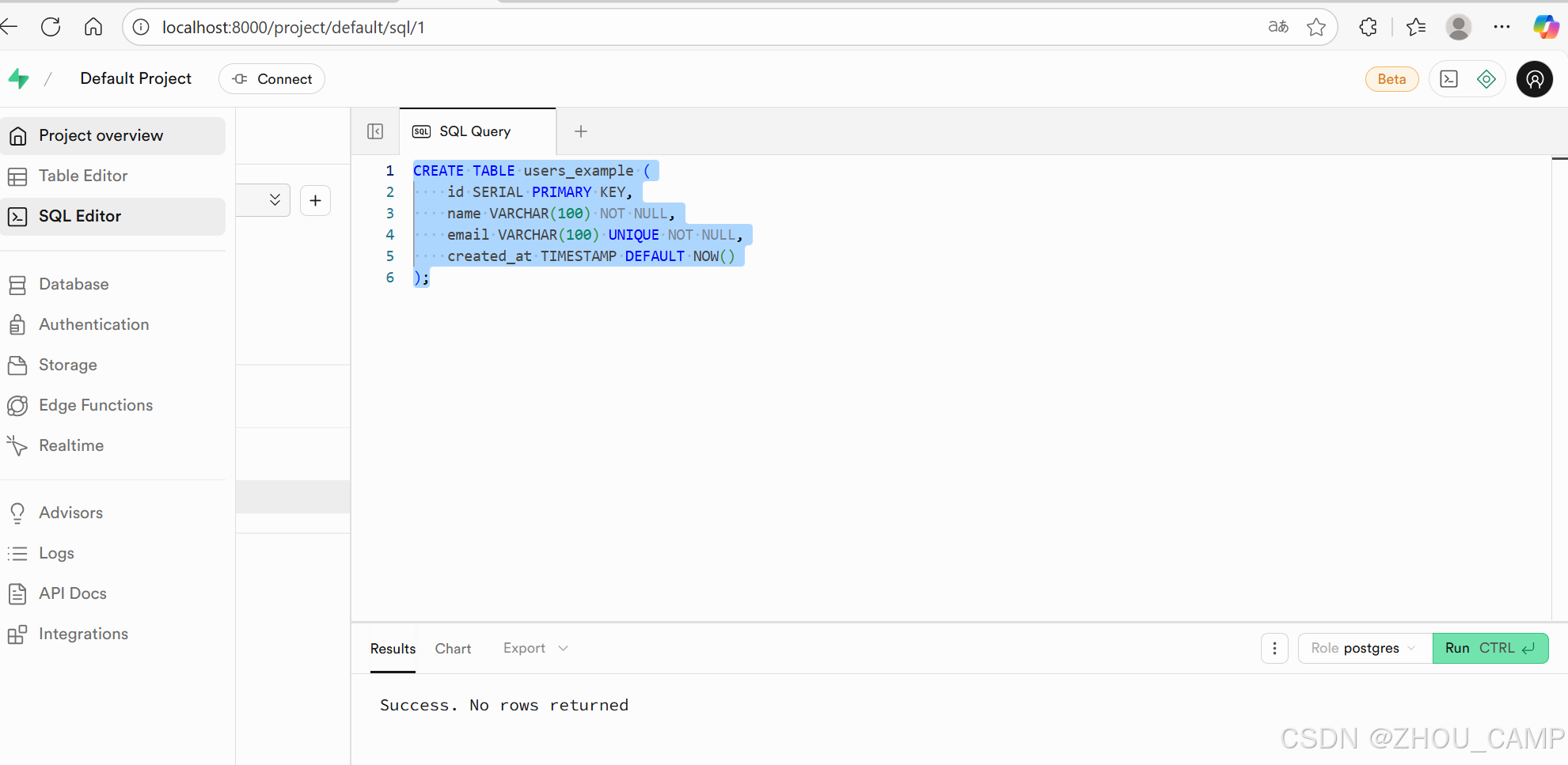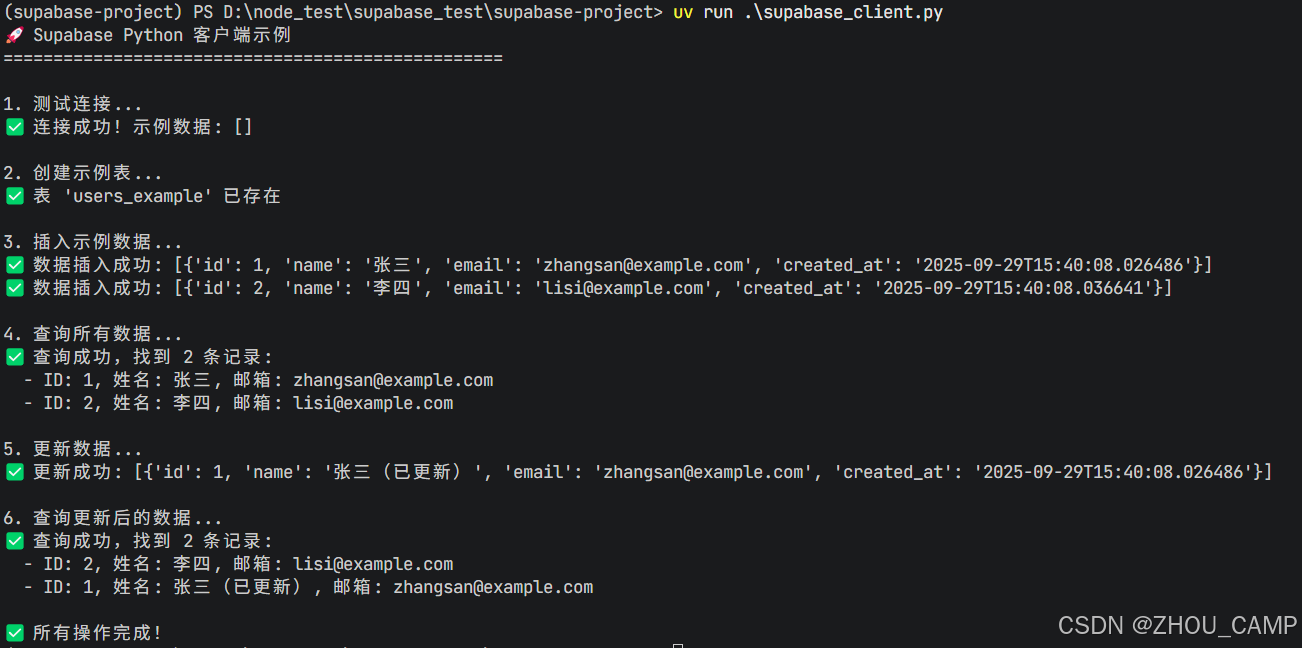windows中部署supabase与测试

目录
windows中部署supabase与测试
Supabase 介绍
Supabase 是一个开源的 Firebase 替代品,提供基于 PostgreSQL 数据库的后端即服务(BaaS)解决方案。
核心特性:
🔧 主要组件
- PostgreSQL 数据库 - 完全功能的关系型数据库
- 身份认证 - 完整的用户管理系统
- 即时 API - 自动生成 RESTful API
- 实时订阅 - 数据库变更的实时监听
- 存储 - 文件存储和管理
- Edge Functions - 服务器端函数
🚀 技术优势
- 开源 - 可自行部署,避免供应商锁定
- PostgreSQL 强大功能 - 支持 SQL、触发器、存储过程等
- 自动生成 API - 无需手动编写 CRUD 接口
- 实时能力 - 内置 WebSocket 支持
- 扩展性强 - 基于成熟的 PostgreSQL 生态
🔄 与 Firebase 对比
- 使用 SQL 而非 NoSQL
- 更强大的查询能力
- 更好的数据关系处理
- 开源且可自托管
🎯 适用场景
- 需要快速原型的项目
- 实时应用(聊天、协作工具)
- 需要复杂查询的应用程序
- 希望避免供应商锁定的项目
Supabase 让开发者能够快速构建后端服务,同时保持对数据的完全控制和灵活性。
部署supabase
# 获取源代码
git clone --depth 1 https://github.com/supabase/supabase
# 创建新的Supabase项目目录
mkdir supabase-project
# 目录结构应如下所示:
# .
# ├── supabase
# └── supabase-project
# 将compose文件复制到您的项目中
# cp -rf supabase/docker/* supabase-project ## Linux系统命令
Copy-Item -Path supabase/docker/* -Destination supabase-project -Recurse -Force
# 复制环境变量示例文件
cp supabase/docker/.env.example supabase-project/.env
# 切换到项目目录
cd supabase-project
# 拉取最新的Docker镜像
docker compose pull
# 启动所有服务(后台模式)
docker compose up -d

登录
您可以通过8000端口上的API网关访问Supabase Studio。例如:http://<您的IP地址>:8000,若在本地运行Docker则可使用localhost:8000。
系统将提示您输入用户名和密码。默认登录凭证为:
用户名:supabase
密码:this_password_is_insecure_and_should_be_updated
创建表
CREATE TABLE users_example (
id SERIAL PRIMARY KEY,
name VARCHAR(100) NOT NULL,
email VARCHAR(100) UNIQUE NOT NULL,
created_at TIMESTAMP DEFAULT NOW()
);
python测试
1、requirements.txt文件
# Supabase Python 客户端依赖
# Supabase Python 客户端
supabase
# 环境变量管理
python-dotenv
# HTTP 请求库(supabase 的依赖)
httpx
# PostgreSQL 适配器(可选,用于直接数据库连接)
psycopg2-binary
# 异步支持(可选)
asyncio
# JSON 处理(通常已内置,但确保兼容性)
ujson2、环境配置:
uv init
uv venv --python 3.12
.\.venv\Scripts\activate
uv pip install -r .\requirements.txt3、Supabase Python 客户端示例文件
"""
Supabase Python 客户端示例
这个脚本演示如何使用 Python 连接和操作 Supabase 数据库
"""
import os
from supabase import create_client, Client
from dotenv import load_dotenv
# 加载环境变量
load_dotenv()
class SupabaseClient:
def __init__(self):
"""初始化 Supabase 客户端"""
# 从环境变量获取配置
self.url = os.getenv('SUPABASE_PUBLIC_URL', 'http://localhost:8000')
self.anon_key = os.getenv('ANON_KEY')
self.service_role_key = os.getenv('SERVICE_ROLE_KEY')
if not self.anon_key:
raise ValueError("ANON_KEY 环境变量未设置")
# 创建客户端(使用匿名密钥进行一般操作)
self.supabase: Client = create_client(self.url, self.anon_key)
# 创建服务角色客户端(用于管理员操作)
if self.service_role_key:
self.admin_client: Client = create_client(self.url, self.service_role_key)
else:
self.admin_client = None
def test_connection(self):
"""测试连接:先建表,再查询"""
try:
response = self.supabase.table("users_example").select("*").limit(1).execute()
print(f"✅ 连接成功!示例数据: {response.data}")
return True
except Exception as e:
print(f"❌ 连接失败: {e}")
return False
def create_table_example(self):
"""创建示例表"""
try:
# 首先检查表是否已存在
try:
response = self.supabase.table('users_example').select('*').limit(1).execute()
print("✅ 表 'users_example' 已存在")
return True
except:
# 表不存在,需要创建
print("⚠️ 表 'users_example' 不存在")
print("请在 Supabase Studio (http://localhost:3000) 中手动创建表:")
print("""
CREATE TABLE users_example (
id SERIAL PRIMARY KEY,
name VARCHAR(100) NOT NULL,
email VARCHAR(100) UNIQUE NOT NULL,
created_at TIMESTAMP DEFAULT NOW()
);
""")
# 等待用户创建表后再次检查
input("创建表后按 Enter 键继续...")
try:
response = self.supabase.table('users_example').select('*').limit(1).execute()
print("✅ 表创建成功!")
return True
except:
print("❌ 表仍然不存在,跳过数据操作")
return False
except Exception as e:
print(f"❌ 检查表失败: {e}")
return False
def insert_data_example(self, name: str, email: str):
"""插入数据示例"""
try:
data = {
"name": name,
"email": email
}
response = self.supabase.table('users_example').insert(data).execute()
print(f"✅ 数据插入成功: {response.data}")
return response.data
except Exception as e:
print(f"❌ 插入数据失败: {e}")
return None
def select_data_example(self):
"""查询数据示例"""
try:
response = self.supabase.table('users_example').select("*").execute()
print(f"✅ 查询成功,找到 {len(response.data)} 条记录:")
for record in response.data:
print(f" - ID: {record['id']}, 姓名: {record['name']}, 邮箱: {record['email']}")
return response.data
except Exception as e:
print(f"❌ 查询失败: {e}")
return None
def update_data_example(self, user_id: int, new_name: str):
"""更新数据示例"""
try:
response = self.supabase.table('users_example').update(
{"name": new_name}
).eq('id', user_id).execute()
print(f"✅ 更新成功: {response.data}")
return response.data
except Exception as e:
print(f"❌ 更新失败: {e}")
return None
def delete_data_example(self, user_id: int):
"""删除数据示例"""
try:
response = self.supabase.table('users_example').delete().eq('id', user_id).execute()
print(f"✅ 删除成功: {response.data}")
return response.data
except Exception as e:
print(f"❌ 删除失败: {e}")
return None
def main():
"""主函数 - 演示基本操作"""
print("🚀 Supabase Python 客户端示例")
print("=" * 50)
try:
# 初始化客户端
client = SupabaseClient()
# 测试连接
print("\n1. 测试连接...")
if not client.test_connection():
return
# 创建示例表
print("\n2. 创建示例表...")
client.create_table_example()
# 插入数据
print("\n3. 插入示例数据...")
client.insert_data_example("张三", "zhangsan@example.com")
client.insert_data_example("李四", "lisi@example.com")
# 查询数据
print("\n4. 查询所有数据...")
client.select_data_example()
# 更新数据
print("\n5. 更新数据...")
client.update_data_example(1, "张三(已更新)")
# 再次查询
print("\n6. 查询更新后的数据...")
client.select_data_example()
print("\n✅ 所有操作完成!")
except Exception as e:
print(f"❌ 程序执行出错: {e}")
if __name__ == "__main__":
main()输出